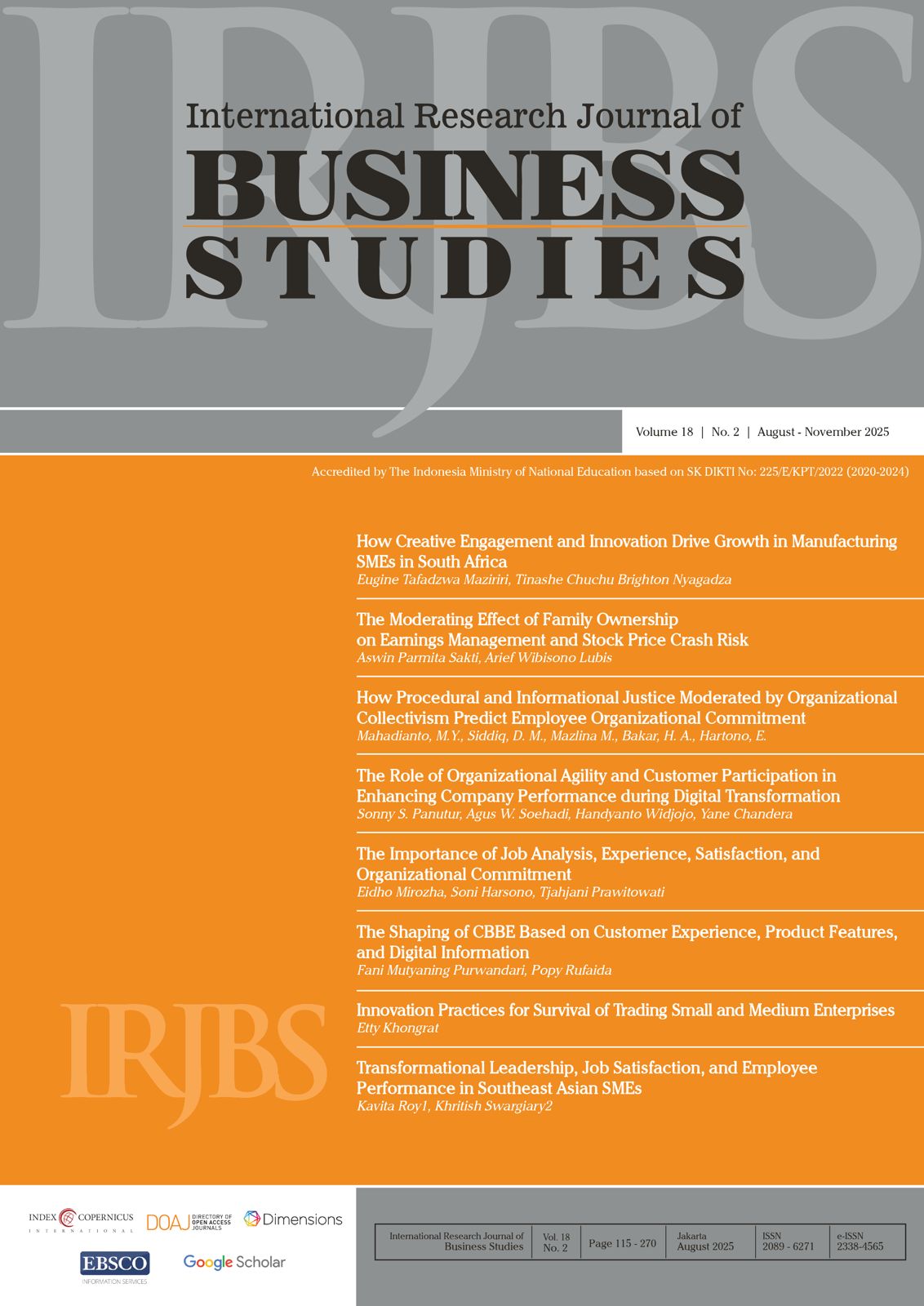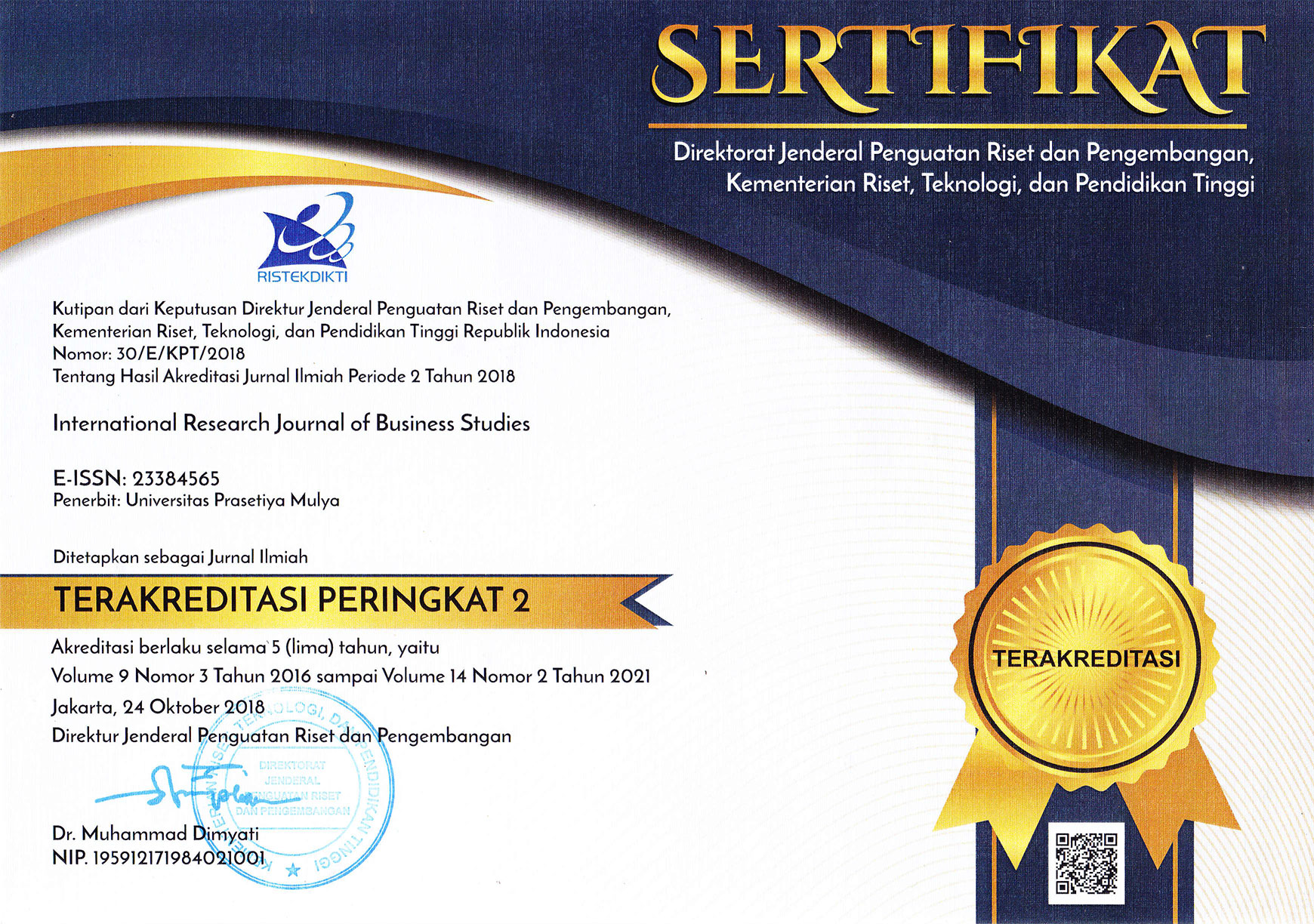Transformational Leadership, Job Satisfaction, and Employee Performance in Southeast Asian SMEs
DOI:
https://doi.org/10.21632/irjbs.18.2.253-270Keywords:
Transformational Leadership, Job Satisfaction, Organizational Culture, Southeast Asian SMEsAbstract
This study investigates the influence of transformational leadership on employee performance in small and medium enterprises (SMEs) across Southeast Asia, focusing on Malaysia, Singapore, and Thailand. Employing a quantitative cross-sectional survey design, data were gathered from employees using validated scales such as the Multifactor Leadership Questionnaire, Job Satisfaction Survey, Organizational Culture Assessment Instrument, and Employee Performance Scale. Structural equation modeling analysis revealed that transformational leadership positively impacts both job satisfaction and employee performance, with job satisfaction partially mediating this relationship. Organizational culture, particularly clan and hierarchy type, moderates these effects, with clan culture enhancing the leadership-satisfaction link and hierarchy culture diminishing the leadership-performance link. Cross-country differences indicate a stronger leadership-satisfaction effect in Malaysia. These findings highlight the pivotal role of leadership and culture in driving SME performance in Southeast Asia.
References
Armstrong, M., & Taylor, S. (2014). Armstrong's handbook of human resource management practice. Kogan Page Publishers.
ASEAN Secretariat. (2020). ASEAN economic integration brief. Retrieved from https://asean.org/storage/2020/12/ASEAN_Economic_Integration_Brief_AEIB_No_07.pdf
Asia Development Bank. (2018). Asia SME finance monitor 2018. Retrieved from https://www.adb.org/publications/asia-sme-finance-monitor-2018
Avolio, B. J., & Yammarino, F. J. (2013). Transformational and charismatic leadership: The road ahead. Emerald Group Publishing.
Avolio, B. J., Walumbwa, F. O., & Weber, T. J. (2009). Leadership: Current theories, research, and future directions. Annual Review of Psychology, 60, 421-449.
Bass, B. M. (1985). Leadership and performance beyond expectations. Free Press.
Bass, B. M., & Avolio, B. J. (1994). Improving organizational effectiveness through transformational leadership. Sage.
Bass, B. M., & Avolio, B. J. (1995). MLQ multifactor leadership questionnaire. Redwood City, CA: Mind Garden.
Bass, B. M., & Riggio, R. E. (2006). Transformational leadership (2nd ed.). Lawrence Erlbaum Associates.
Bass, B. M., & Riggio, R. E. (2006). Transformational leadership (2nd ed.). Lawrence Erlbaum Associates.
Borman, W. C., & Motowidlo, S. J. (1993). Expanding the criterion domain to include elements of contextual performance. In N. Schmitt & W. C. Borman (Eds.), Personnel selection in organizations (pp. 71-98). Jossey-Bass.
Braun, S., Peus, C., Weisweiler, S., & Frey, D. (2013). Transformational leadership, job satisfaction, and team performance: A multilevel mediation model of trust. The Leadership Quarterly, 24(1), 270-283.
Burns, J. M. (1978). Leadership. Harper & Row.
Cameron, K. S., & Quinn, R. E. (2006). Diagnosing and changing organizational culture: Based on the competing values framework. Jossey-Bass.
Denison, D. R. (1996). What is the difference between organizational culture and organizational climate? A native's point of view on a decade of paradigm wars. Academy of Management Review, 21(3), 619-654.
Denison, D. R., & Mishra, A. K. (1995). Toward a theory of organizational culture and effectiveness. Organization Science, 6(2), 204-223.
Dvir, T., Eden, D., Avolio, B. J., & Shamir, B. (2002). Impact of transformational leadership on follower development and performance: A field experiment. Academy of Management Journal, 45(4), 735-744.
F. (2004). Transformational and transactional leadership: A meta-analytic test of their relative validity. Journal of Applied Psychology, 89(5), 755-768.
Hartnell, C. A., Ou, A. Y., & Kinicki, A. (2011). Organizational culture and organizational effectiveness: A meta-analytic investigation of the competing values framework's theoretical suppositions. Journal of Applied Psychology, 96(4), 677-694.
Hofstede, G. (2001). Culture's consequences: Comparing values, behaviors, institutions, and organizations across nations (2nd ed.). Sage Publications.
House, R. J., Hanges, P. J., Javidan, M., Dorfman, P. W., & Gupta, V. (Eds.). (2004). Culture, leadership, and organizations: The GLOBE study of 62 societies. Sage Publications.
Judge, T. A., & Piccolo, R. F. (2004). Transformational and transactional leadership: A meta-analytic test of their relative validity. Journal of Applied Psychology, 89(5), 755-768.
Judge, T. A., Thoresen, C. J., Bono, J. E., & Patton, G. K. (2001). The job satisfaction–job performance relationship: A qualitative and quantitative review. Psychological Bulletin, 127(3), 376-407.
Kirkpatrick, S. A., & Locke, E. A. (1996). Direct and indirect effects of three core charismatic leadership components on performance and attitudes. Journal of Applied Psychology, 81(1), 36-51.
Locke, E. A. (1976). The nature and causes of job satisfaction. In M. D. Dunnette (Ed.), Handbook of industrial and organizational psychology (pp. 1297-1349). Rand McNally.
Northouse, P. G. (2018). Leadership: Theory and practice. Sage Publications.
Ogbonna, E., & Harris, L. C. (2000). Leadership style, organizational culture and performance: Empirical evidence from UK companies. International Journal of Human Resource Management, 11(4), 766-788.
Rowley, C., & Warner, M. (2007). Management in South-East Asia: Business culture, enterprises and human resources. Routledge.
Schein, E. H. (2010). Organizational culture and leadership (4th ed.). John Wiley & Sons.
Spector, P. E. (1997). Job satisfaction: Application, assessment, causes, and consequences. Sage Publications.
Wang, G., Oh, I. S., Courtright, S. H., & Colbert, A. E. (2011). Transformational leadership and performance across criteria and levels: A meta-analytic review of 25 years of research. Group & Organization Management, 36(2), 223-270.
Xenikou, A., & Simosi, M. (2006). Organizational culture and transformational leadership as predictors of business unit performance. Journal of Managerial Psychology, 21(6), 566-579.
Downloads
Submitted
Accepted
Published
How to Cite
Issue
Section
Categories
License
Copyright (c) 2025 Khritish Swargiary, Kavita Roy (Author)

This work is licensed under a Creative Commons Attribution-ShareAlike 4.0 International License.
Journal Author(s) Rights
For IRJBS to publish and disseminate research articles, we need publishing rights (transferred from the author(s) to the publisher). This is determined by a publishing agreement between the Author(s) and IRJBS. This agreement deals with the transfer or license of the copyright of publishing to IRJBS, while Authors still retain significant rights to use and share their own published articles. IRJBS supports the need for authors to share, disseminate and maximize the impact of their research and these rights, in any databases.
As a journal Author, you have rights to many uses of your article, including use by your employing institute or company. These Author rights can be exercised without the need to obtain specific permission. Authors publishing in IRJBS journals have comprehensive rights to use their works for teaching and scholarly purposes without needing to seek permission, including:
- use for classroom teaching by Author or Author's institution and presentation at a meeting or conference and distributing copies to attendees;
- use for internal training by the author's company;
- distribution to colleagues for their research use;
- use in a subsequent compilation of the author's works;
- inclusion in a thesis or dissertation;
- reuse of portions or extracts from the article in other works (with full acknowledgment of the final article);
- preparation of derivative works (other than commercial purposes) (with full acknowledgment of the final article);
- voluntary posting on open websites operated by the author or the author’s institution for scholarly purposes,
(But it should follow the open access license of Creative Common CC-by-SA License).
Authors/Readers/Third Parties can copy and redistribute the material in any medium or format, as well as remix, transform, and build upon the material for any purpose, even commercially. Still, they must give appropriate credit (the name of the creator and attribution parties (authors' detail information), a copyright notice, an open access license notice, a disclaimer notice, and a link to the material), provide a link to the license, and indicate if changes were made (Publisher indicates the modification of the material (if any) and retain an indication of previous modifications.
Authors/Readers/Third Parties can read, print and download, redistribute or republish the article (e.g. display in a repository), translate the article, download for text and data mining purposes, reuse portions or extracts from the article in other works, sell or re-use for commercial purposes, remix, transform, or build upon the material, they must distribute their contributions under the same license as the original Creative Commons Attribution-ShareAlike (CC BY-SA).
This work is licensed under a Creative Commons Attribution-ShareAlike 4.0 International License.








